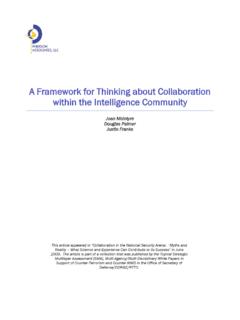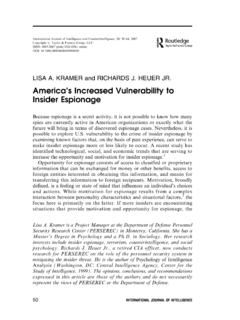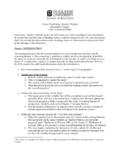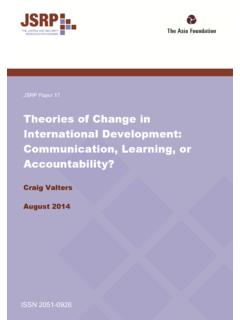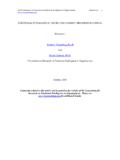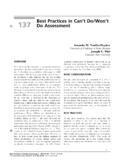Transcription of How Does Analysis of Competing Hypotheses (ACH)
1 How does Analysis of Competing Hypotheses (ACH) Improve Intelligence Analysis ? Richards J. Heuer, Jr. Version , October 16, 2005 This document is from a collection of works by Richards J. Heuer, Jr. that has been established by Pherson Associates to make the author s papers more accessible to the general public. Richards J. Heuer, Jr. has given exclusive rights to Pherson Associates to post his works on their website. This article is copyright protected and may not be reproduced for commercial use without the express permission of Pherson Associates. To reproduce this article for educational use, read more articles by Richards J. Heuer, Jr.
2 , or learn more about the use of Structured Analytic Techniques, please visit 2 How does Analysis of Competing Hypotheses (ACH) Improve Intelligence Analysis ? By Richards J. Heuer, Jr. This paper identifies three different approaches to Analysis of Competing Hypotheses (ACH) and four major steps in the intelligence Analysis process. It then examines how each of these three approaches to ACH affects performance of each of the four steps in the analytical process. It also compares these three approaches on two dimensions the analytical benefit from its use and the cost (in analytical time and resources) to use ACH. A simple model of how most intelligence analysts actually work involves four steps.
3 When given an assignment, analysts (1) search for information, (2) assemble and organize the information in a manner designed to facilitate Analysis , (3) analyze the information to make an estimative judgment, and (4) write a report. The three approaches to ACH are (1) the original manual approach as described in my book Psychology of Intelligence Analysis , (2) the automated version developed with my assistance by Palo Alto Research Center (PARC) for the Intelligence Community, and (3) Bayesian and other advanced forms of ACH, of which there are now multiple versions. Bayesian inference is a statistical procedure for quantifying uncertainty. Probabilities are based on degrees of belief rather than frequencies.
4 Hence it is an appropriate method for aggregating a series of subjective probability judgments by intelligence analysts or other experts. Each of these three approaches provides some analytical benefit at all four steps in the analytical process, but the amount of benefit differs for each step with each type of ACH and involves different trade-offs between analytical benefit, ease of use, and cost in analytical time. Step 1- Search for Information The requirement to identify and examine simultaneously a full set of Hypotheses is the essential element that is common to all forms of ACH. The goal is to help the analyst question his or her initial mindset. Consideration of alternative Hypotheses drives a much broader search for information than busy analysts would otherwise pursue.
5 The focus on rejecting Hypotheses also 3 casts a different perspective on what information the analyst searches for and considers most valuable. This first step in the analytical process is probably where any form of ACH does the most to help the analyst avoid being caught by surprise. When analysts are first exposed to ACH and say they find it useful, it is because the simple focus on identifying alternative Hypotheses and how they might be disproved prompts analysts to think seriously about evidence, explanations, or outcomes that had not previously occurred to them. This benefit during the first step of the Analysis is roughly comparable for all forms of ACH. The automated and Bayesian approaches to ACH provide some additional benefit as they facilitate iterative steps that require the analyst to reevaluate Hypotheses periodically or conduct further search for disconfirming evidence.
6 If an analyst is working a new area or issue, ACH might actually save the analyst some time. If the analyst must start by simply immersing himself or herself in the data, ACH can provide direction to what otherwise might be a rather random search. In most cases, however, using ACH during this first step does involve a substantial cost in analytical time. If the analyst is already generally knowledgeable on the topic, the usual procedure is to develop a favored hypothesis and then search for evidence to confirm it. This is a satisficing approach, going with the first answer that seems to be supported by the evidence. This is efficient, because it saves time and works much of the time.
7 It is usually also a safe approach, as the result may differ little, if at all, from the conventional wisdom. However, the analyst has made no investment in protection against surprise. The conventional satisficing approach provides no stimulus for the analyst to identify and question fundamental assumptions. It bypasses the Analysis of alternative explanations or outcomes, which should be fundamental to any complete Analysis . As a result, it fails to distinguish that much evidence seemingly supportive of the favored hypothesis is also consistent with one or more alternative Hypotheses . It often fails to recognize the importance of what is missing, , what should be observable if a given hypothesis is true, but is not there.
8 During this first step in the analytical process, ACH is a simple conceptual strategy for dealing with a complex problem, and the principal benefit from any form of ACH comes from this conceptual strategy. An analyst does not need any analytical tool or methodology to do it. 4 Identifying and thinking about alternative Hypotheses and how they might be refuted can and should be ingrained as a standard analytical habit. It is clearly preferable to the satisficing approach whenever the issue is so important that the analyst cannot afford to be wrong, and for other estimative judgments when the analyst has time for systematic Analysis as distinct from simply expressing an expert opinion.
9 Step 2 Assemble and Organize Information The second step in Analysis is to assemble the collected information and organize it in some analytically useful way, so that it can be readily retrieved for use in the Analysis . The simplest form of this is the analyst s shoebox with note cards. There are a number of simple tools that analysts use to help overcome limitations in human mental machinery for perception, memory, and inference. They all use two basic principles decomposition and externalization. Decomposition means breaking a problem down into its component parts. Externalization means getting the decomposed problem out of one s head and down on paper or in a computer in some simplified form that shows the main variables, parameters, or elements of the problem and how they relate to each other.
10 All three forms of ACH use a matrix for this purpose, breaking the analytical problem down into its component parts by showing the evidence and Hypotheses and how they relate to each other. This is a valuable contribution, as it organizes the information in a manner designed to facilitate Analysis . The complexity of this matrix and the judgments that go into its development clearly differentiate the three types of ACH. Manual ACH The original manual ACH matrix records only the estimated relationship between each item of evidence and each hypothesis. That is, the analyst notes whether each item of evidence is consistent or inconsistent, or very consistent or very inconsistent, with each hypothesis.
